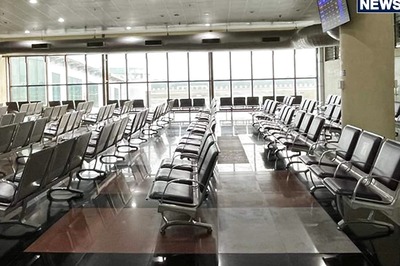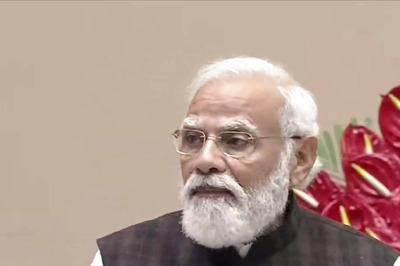
views
Kandahar: The massive security breach that allowed the Taliban to spirit more than 480 Afghan inmates out southern Afghanistan's largest prison must have involved inside collaborators, the Justice Ministry said on Tuesday, as security forces worked to recapture the escaped convicts.
Prison officials discovered early Monday morning that the inmates - nearly all of them Taliban militants - were missing from their cells, and then found the tunnel through which they appeared to have made their getaway.
The Taliban said the prison break was five months in the making, with diggers starting the tunnel from under a nearby house while they arranged for inmates to get keys so that they could open their cells on the night of the escape.
Government officials started to piece through the details of the escape on Tuesday and place blame. Justice Minister Habibullah Ghalib sent a formal letter to President Hamid Karzai acknowledging that prison officials or guards likely acted as accomplices but also saying that Afghan and international security forces should have detected the plot.
"The escape of all the prisoners from one tunnel shows that collaborators inside the prison somehow provided an opportunity," Ghalib said in the letter.
However, he also noted that Afghan police searched the compound from which the tunnel originated about two and a half months before the prison break and he said that Canadian and American forces have been responsible for security improvements to the prison. A full investigation is under way.
An intelligence officer who is involved in the investigation, General Tahir Mohmand, said that they had warned prison officials a number of times recently that they had reports that the Taliban were planning some sort of operation involving the prison.
"We had some clues that the Taliban were busy in some kind of plan to get their prisoners out," he said.
More details came from those who had been caught.
Samiullah Jan, who had served 13 months of a 14 month sentence, said he was woken up at midnight and escorted to the tunnel, which was lighted and even had a pipe running through it that they were told was pushing out oxygen to help them breathe.
"When we got out of the tunnel they let us go and said 'Now you can go home. Go wherever you want.' I moved around a bit but I didn't have any place to go, and then the soldiers found me," Jan said. He spoke from his cell at the intelligence agency's detention center in Kandahar.
The Kandahar provincial governor's office said troops have already caught 71 of those who escaped and killed two who tried to resist. Authorities have biometric data on each prisoner, which aids in their identification, the governor's office said.
But even if a sizable number of the convicts are recaptured, the already weak provincial government is still reeling from the blow to its image.
The prison break also came less than two weeks after the Kandahar police chief was killed by a suicide bomber inside his heavily defended office compound.
"How can we trust or rely on a government that can't protect the police chief inside the police headquarters and can't keep prisoners in the prison?" asked Islamullah Agha Bashir, who sells washing machines and other appliances in Kandahar city. "Last night while we were eating dinner I told my two sons not to go out as much because I am afraid that now when the morale of the Taliban is high, they will attack more."
Kandahar Governor Tooryalai Wesa said that residents should not be worried.
"The security situation in Kandahar will not get worse. I have confidence in my intelligence officers and our supporters," Wesa said.
Kandahar city has been a major focus of the international troop surge over the past year, with NATO officials saying that establishing security there will be key to securing the region. Last summer, Afghan forces created a ring of checkpoints around the city and started pushing out into Taliban areas to establish the government's authority before the rise in attacks that usually comes in the spring.
The Taliban have responding by starting off the spring fighting season with a string of operations apparently designed to undermine trust in the capabilities of the Afghan government. Within the past two weeks, Taliban agents have also launched deadly attacks from inside the Defense Ministry and a shared Afghan-US military base in eastern Laghman province.
The attacks cast doubt on the readiness of the Afghan government to take over security for parts of the country as planned, threatening the exit strategy for the country's allies eager to bring troops home.
NATO does continue to have tactical successes, announcing on Tuesday that it had killed a key al-Qaida operative in Afghanistan in an airstrike.
NATO identified the man killed in the April 13 airstrike in Dangam district of eastern Kunar province as Abu Hafs al-Najdi, also known as Abdul Ghani. The alliance said he was a regional commander in charge of suicide bombings and cash flow. The strike also killed a number of other insurgents, including another al-Qaida leader known as Waqas.
But Afghans tend to focus on the continuing danger they face in their daily lives - either as government workers who may be targeted or just that they could be a bystander when a suicide bomb goes off.
In eastern Paktia province on Tuesday, the provincial governor narrowly escaped an apparent assassination attempt by insurgents. A roadside bomb exploded just behind a vehicle taking Governor Juma Khan Hamdard to his office, said Rohallah Samon, a spokesman.
Hamdard was not hurt, but three policemen who were in a chase vehicle were slightly injured, Samon said.




















Comments
0 comment